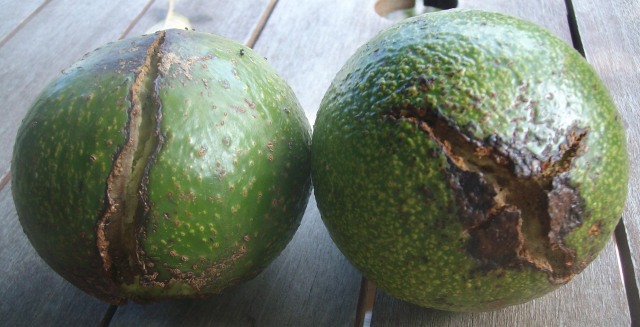by Laurie Meadows
This is another old avocado variety that has been around for many years but has never become popular (it was selected in Santa Monica, USA, in 1938, and imported into New Zealand soon after World War 2). It seems the avocado was named 'Hellen', rather than 'Helen'.
"The Hellen,
another green summer and fall fruit, gives promise of not
only being a
vigorous tree, but fairly precocious and a consistent bearer. This variety also is being
grown in most districts... Young trees at Santa Paula and at Carpinteria, in spite of tree vigor,
are bearing quite a number of fruits. The Hellen is a tree having a spreading habit and
should be planted with about the same allowance for space as the Fuerte."
- '1943 Observations of Avocado Varieties', California Avocado Society 1943 Yearbook
We were given some scionwood, so I grafted it onto a
big seedling. The graft blew out after a few years, but the
tree has recovered from a small undamaged bit of wood just
above the graftline, and now has its second ever crop.vigorous tree, but fairly precocious and a consistent bearer. This variety also is being
grown in most districts... Young trees at Santa Paula and at Carpinteria, in spite of tree vigor,
are bearing quite a number of fruits. The Hellen is a tree having a spreading habit and
should be planted with about the same allowance for space as the Fuerte."
- '1943 Observations of Avocado Varieties', California Avocado Society 1943 Yearbook
A small Hellen tree, about head high. It is carrying 50 fruit.
One account says the tree is vigorous and upright, another says Hellen is spreading, but more compact than Fuerte (a tree that spreads wide). It is relatively small and bushy for us - maybe partly because of poor compatibility with the rootstock. I suspect there are 2 similar avocados propagated as 'Hellen'. Certainly, the seed from the fruit of the tree we have here under the name 'Hellen' is quite different to the one illustrated by the University of California. The UCLA site says Hellen is a 'B' type, but the tree here is an 'A' type.
Flowering is november, about the same time as Reed, maybe starting a touch later. Late flowering is a distinct advantage, because the weather is warmer and there are heaps of pollinating insects around (although there is debate over how important insect pollination is in New Zealand's humid conditions).
It is a late season green-skinned fruit, like Reed. And like Reed, it has a thick skin, so it is hard to tell when it is ripe In fact, the skin is even thicker and more 'shell-like' than Reed. Even when well overripe the skin still feels firm. (The University of California database says it has a 'leathery' skin. As stated, I have seen reference to the possibility that two similar fruits are both called Hellen)
When it is picked before it is fully mature, the outer skin may develop black specks. These are entirely superficial, and don't penetrate to the flesh below, which remains perfectly sound.
Hellen can develop black skin specks if it is picked a little underipe
Hellen fruit tend to be inside the canopy
The flesh quality is good, but not outstanding. I'd rate it 'very good minus'. (In comparison, I would rate a full ripe Hass as 'excellent', and Reed as 'excellent plus'.) The flesh seems to be mid yellow, and doesn't discolor in the fridge. While the flesh is smooth, it is not really oily. Equally, it is certainly not watery - in fact it has a sort of 'dry' texture (not literally!). There don't appear to be fibers in the flesh. A few little granules from cutting the thick skin sometimes drop into the flesh, which is mildly annoying. The seed falls easily from the fruit, totally free of adhering flesh.
Hellen's main season here seems to be early-mid march to late april. Later set fruit will hang on into mid may. They can be picked as early as late February, but may be a bit slower to ripen. If there is lots of rain following a dry spell about mid march, some fruit may swell, split, and fall from the tree. Some early-set Hellen tend to be a little over mature by the end of march. At that point the fibres are more prominent in the flesh, the seed is sprouting inside the fruit, and the fruit is likely to fall from the tree.
In the 2012 fruiting season, Hellen still held 12 fruit on the tree at april 28th, from a total crop of 50 fruit. So around a quarter of the crop remain on the tree in late april. At this stage of the year, most are now scarred by possum or rat attempt to eat the fruit on the tree. Maybe the thick 'shell' has some uses after all. By mid may, half the 'late' fruit had fallen naturally.

Helen can split and fall from the tree
All in all, Reed is a better fruit, is in the same season, and may suit hard pruning better than Helen. Hass, the supreme King of avocados, may still be holding late-set fruit from its summer crop. No contest.
Links
http://www.nzavocado.co.nz/History/Avoscene%20Sept%2008%2019-23%20art.pdf
http://ucavo.ucr.edu/avocadovarieties/VarietyList/Hellen.html
If you have corrections, observations, or comments, feel free to drop a line to:
avocado [and next insert the symbol "@"] lauriemeadows "dot" info. Apologies in advance, I don't check email very often, so acknowledgement may be a wee while coming.